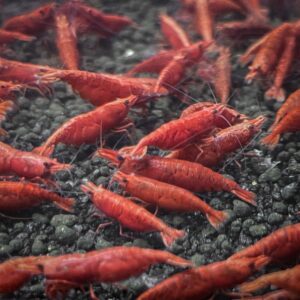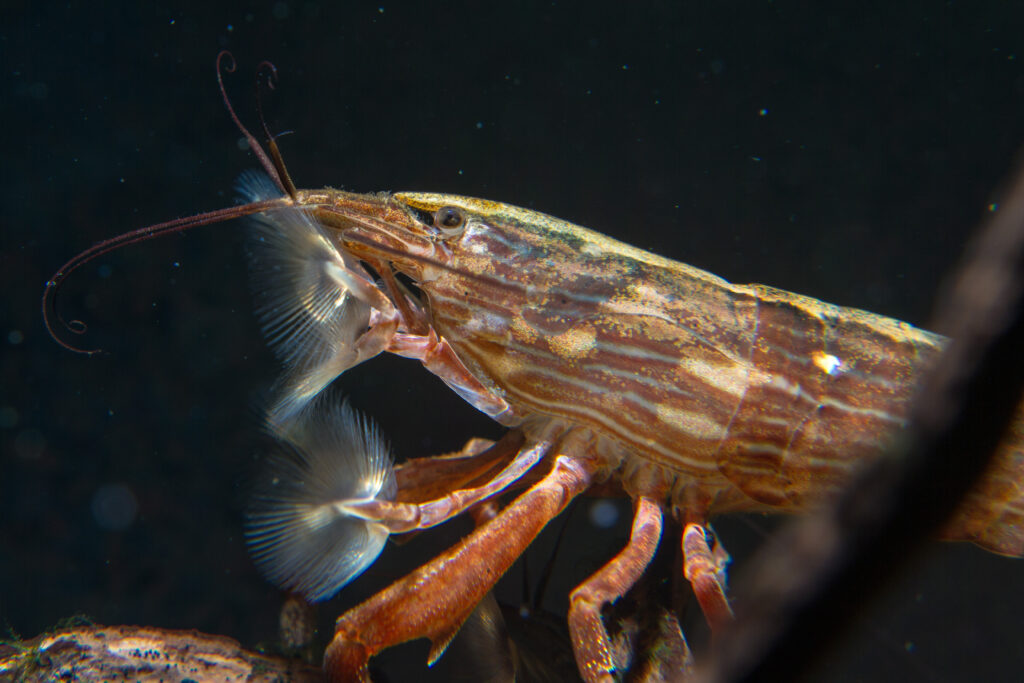In this guide, we’ll explore some of the most popular and beginner-friendly freshwater shrimp species, including:
- Red Cherry Shrimp (Neocaridina davidi var. red)
- Blue Dream Shrimp (Neocaridina davidi var. blue)
- Amano Shrimp (Caridina multidentata)
- Bamboo Shrimp (Atyopsis moluccensis)
Each species profile will cover appearance, care requirements, breeding potential, and compatibility with other aquarium inhabitants. By the end of this guide, you’ll have a solid foundation for choosing and caring for your first freshwater shrimp species.
Beginner-Friendly Shrimp Species
Neocaridina
Description and varieties: Neocaridina shrimp are among the most popular and colorful freshwater shrimp in the hobby. Originally from Taiwan, these hardy shrimp come in a wide array of colors, including:
- Red Cherry Shrimp (most common)
- Yellow
- Blue Dream
- Green Jade
- Snowball (white)
- Rili (two-toned varieties)
Neocaridina typically grow to about 1-1.5 inches in length and have a lifespan of 1-2 years.
Care requirements:
- Tank size: Minimum 5 gallons, larger for colonies
- Temperature: 65-85°F (18-29°C)
- pH: 6.5-8.0
- GH: 4-8 dGH
- KH: 3-15 dKH
- TDS: 150-250 ppm
Neocaridina are adaptable to a wide range of water parameters, making them ideal for beginners. They thrive in well-planted tanks with plenty of hiding spots and surfaces for grazing.
Amano Shrimp
Description: Amano shrimp (Caridina multidentata), named after aquascaping pioneer Takashi Amano, are larger shrimp growing up to 2 inches. They have a translucent body with distinctive dots or dashes along their sides.
Care requirements: 
- Tank size: Minimum 10 gallons
- Temperature: 70-80°F (21-27°C)
- pH: 6.0-7.6
- GH: 6-8 dGH
- KH: 0-6 dKH
Amano shrimp are hardy and adaptable but prefer stable water conditions. They do well in planted tanks with driftwood and rocks for grazing.
Benefits for aquariums:
- Exceptional algae eaters, particularly effective against hair algae and black beard algae
- Help maintain tank cleanliness by consuming detritus and uneaten food
- Peaceful nature makes them compatible with most community fish
- Add movement and interest to the aquarium
- Long-lived, with a lifespan of 2-3 years under proper care
Amano shrimp are challenging to breed in captivity due to their complex life cycle, which requires brackish water for larval development. As a result, most Amano shrimp in the hobby are wild-caught.
Bamboo Shrimp
Description: Bamboo Shrimp (Atyopsis moluccensis), also known as Wood Shrimp or Fan Shrimp, are unique and fascinating freshwater shrimp. They are significantly larger than many other popular aquarium shrimp species, growing up to 2-3 inches in length. Their most distinctive feature is a pair of fan-like appendages, which they use for feeding.
Bamboo Shrimp have a brownish to reddish-brown coloration that allows them to blend in with driftwood and substrate. Their body is generally translucent, with subtle patterns of stripes or spots. Males are typically smaller and more slender than females.

Special care requirements:
- Tank size: Minimum 20 gallons, with larger tanks preferred
- Water parameters:
- Temperature: 70-78°F (21-26°C)
- pH: 6.5-7.5
- GH: 4-8 dGH
- KH: 3-8 dKH
- Water flow: Moderate to strong current is essential
- Substrate: Sand or fine gravel to prevent damage to their delicate fans
- Hiding spots: Provide plenty of plants, driftwood, and rocks
Bamboo Shrimp are sensitive to poor water quality and sudden changes in parameters. Regular water changes and stable conditions are crucial for their health.
These shrimp are excellent climbers and may attempt to escape if the tank is not properly covered. Ensure all gaps in the tank lid are sealed.
Feeding habits: Bamboo Shrimp have a unique feeding method that sets them apart from many other shrimp species:
- Filter feeding: They are primarily filter feeders, using their fan-like appendages to catch microscopic particles from the water column. This is why a moderate to strong current is essential in their habitat.
- Positioning: Bamboo Shrimp will often position themselves in areas of high water flow, such as near filter outputs or powerheads, to maximize their feeding efficiency.
- Supplemental feeding: In aquariums without sufficient suspended particles, you may need to supplement their diet. Options include:
- Crushed flake food or powdered foods designed for filter feeders
- Phytoplankton or liquid fry food
- Homemade “green water” (cultured algae water)
- Substrate feeding: While they prefer to filter feed, Bamboo Shrimp may occasionally forage on the substrate if food is scarce. However, if you frequently see them doing this, it’s a sign that they’re not getting enough food from the water column.
- Feeding frequency: Offer supplemental foods 2-3 times a week if necessary, but be cautious not to overfeed as this can lead to water quality issues.
It’s important to note that Bamboo Shrimp will not compete well with other bottom-feeding species for traditional sinking foods. Their specialized feeding habits make them unique but also require some extra consideration in terms of tank setup and diet.
When properly cared for, Bamboo Shrimp can be fascinating and beneficial additions to a community tank, helping to keep the water clean while providing an interesting display with their filter-feeding behavior.









